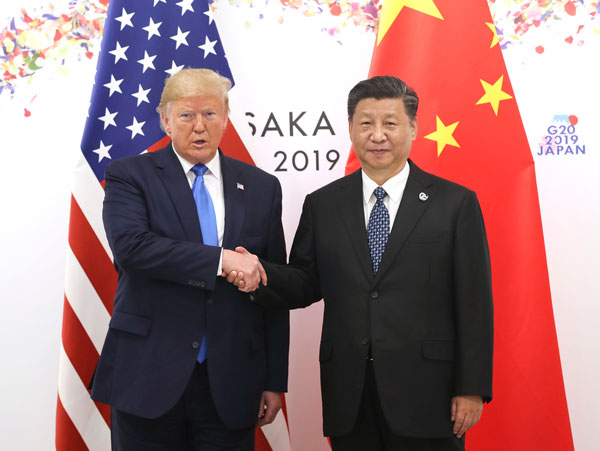
President Xi Jinping (R) meets with US President Donald Trump in Osaka, Japan on June 29, 2019. (Photo: Chinadaily.com.cn)
The world breathed a sigh of relief when presidents Xi Jinping and Donald Trump once again hit the pause button on the unfolding China-US trade war when they met in Osaka on Saturday on the sidelines of the G20 Summit.
Following their June 18 phone conversation, which put the two sides' negotiators back in contact, the Chinese and US leaders formally announced the resumption of trade talks — which is probably the most that could be expected from their meeting.
A meeting that achieved less would have prolonged their standoff, if not added fuel to their frictions, and either of these outcomes would have taken a heavier toll on both economies, sent amplified jitters through the global markets and darkened the prospects for the global economy.
And given the present level of divergences between the two sides, one that accomplished conspicuously more was simply out of the question.
So this was indeed, as the US president put it, "as good as it was going to be". And that is not something to be sniffed at. After all, the meeting removed a tough roadblock, and put the two parties "right back on track".
Given that both sides had seemed to be digging in, it is perhaps an achievement in itself that the two leaders — in what President Xi described as their "course-setting and helm-holding" roles — managed to avert the head-on collision that had appeared imminent.
But although the negotiations are set to reopen where they left off — rekindling hopes of a deal — there is no avoiding the fact that the outcome of their Saturday meeting is still very much like the one the two leaders produced in Argentina in December, another cease-fire.
While avoiding the worst-case scenario and allowing more time, and thus a greater likelihood of maneuvering a deal, Saturday's agreement is no guarantee there will be one.
Even though Washington agreed to postpone levying additional tariffs on Chinese goods to make way for negotiations, and Trump even hinted at putting off decisions on Huawei until the end of negotiations, things are still very much up in the air, and that is how they will no doubt remain until a deal is formally signed, sealed and delivered.
Agreement on 90 percent of the issues has proved not to be enough, and with the remaining 10 percent where their fundamental differences reside, it is not going to be easy to reach a 100-percent consensus, since at this point, they remain widely apart even on the conceptual level.
Striking a badly needed trade deal is proving arduous enough. A remodeled China-US relationship featuring coordination, cooperation, and stability as its keynotes, as Xi proposed in Osaka, is going to require even greater shared resolve to engineer.
For a deal that is acceptable to both parties, and for the well-being of future relations between the two countries, Beijing and Washington must redouble their efforts to bridge the gaps between their respective requests — Beijing's for "equality and respect"; Washington's for "reciprocity" and "fairness".


